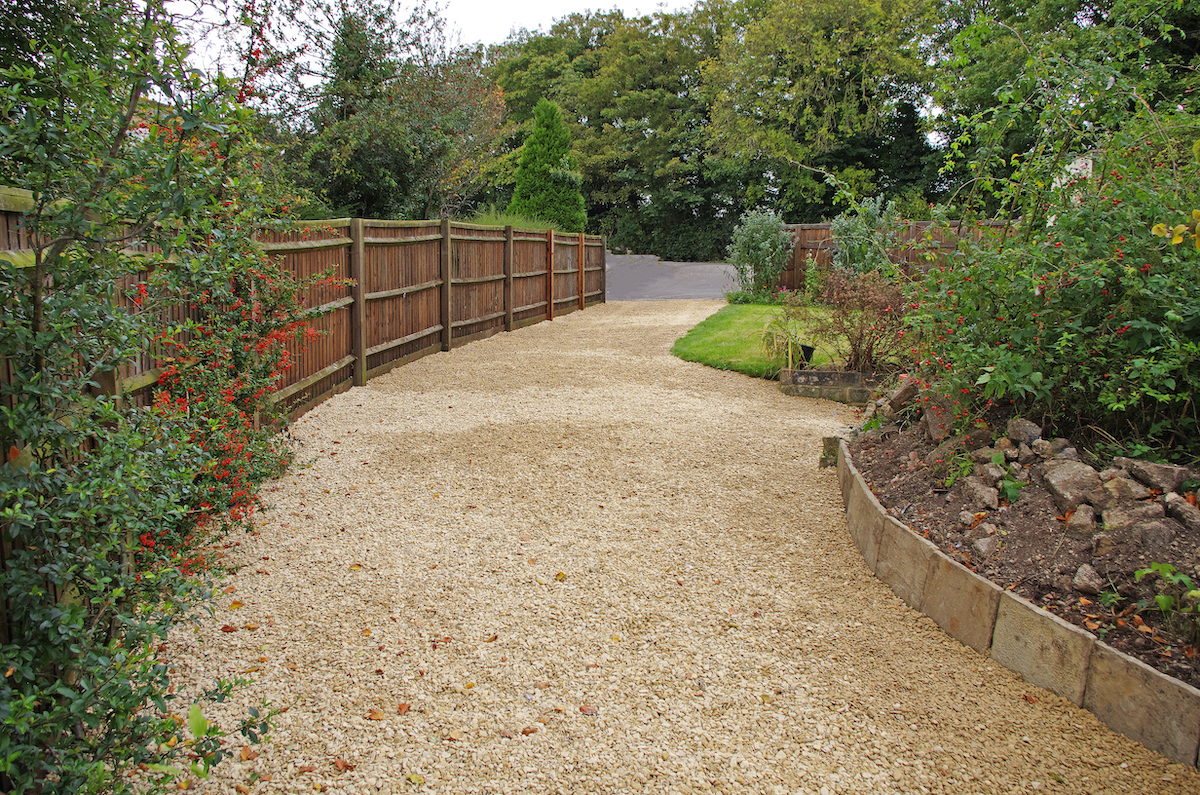

We may earn revenue from the products available on this page and participate in affiliate programs. Learn More ›
A gravel driveway is attractive in an unpretentious way, introducing casual curb appeal to the first and last element of your home that a visitor sees. And whereas poured concrete, asphalt, and patterned brick driveways typically require professional installation, even a somewhat novice DIYer can install a gravel driveway successfully on his or her own without having to pay for design consultation or skilled labor. The cost of a gravel driveway, thus, can be much less than that of a driveway that’s fabricated from other materials.
Though it’s possible to cut corners, a well-made gravel driveway usually consists of three layers. In this striated approach, the bottom layer features 6-inch-diameter crushed rock, while smaller, 2- or 3-inch stones form the middle layer. Only the third layer, the surface, comprises what most of us would recognize as true gravel. Here, eschew smooth stones in favor of rough, angular ones, because these provide a firmer, more stable gravel driveway surface.
Tools & Materials
Bobvila.com may earn a commission from purchases made through these links.
8 Steps to Laying a Gravel Driveway

Step 1: Stake out the driveway’s path.
Using landscape stakes in combination with string or twine, plan the driveway path from the curb all the way to its end point. Will it be straight or circular? Will it slope? These are all important considerations.
Step 2: Clear grass or topsoil from staked area.
To prepare the way for the gravel, you’ll need to remove grass or topsoil from the marked-off area. If you’d rather not do this manually, consider bringing in a bulldozer (and someone to operate it) to make quicker work of this laborious but essential stage of the project.

Tried-and-True Advice
“Local building codes and guidelines for driveway width can be very specific to ensure access for emergency vehicles. We cut a piece of wood to the required width, and walked the entire length of our 800-foot-long [gravel] driveway. (You could also use a piece of twine.) The wood acted as a pre-made guide to help regulate the width and stake placement.”
—Stacey Nash, Contributing Writer
Step 3: Calculate cubic yardage of gravel needed for each driveway layer.
Having cleared a path for the gravel driveway, now you need to calculate the volume of stones you’ll need. To do so, you’ll need to determine the number of cubic yards each layer will occupy.
Start by measuring the length and width (in feet) of the driveway you’ve laid out, then multiply these two numbers together to find your driveway’s square footage. So, if the width is 10 feet and the length is 15 feet, your driveway will be 150 square feet.
Multiply that number by the desired depth of each layer to get the number of cubic feet of stone you’ll need for each layer. The recommended depth for each layer is 4 to 6 inches. If you want a 4-inch layer, divide the square footage by 3 (because 4 inches is one-third of a foot).
Now that you’ve calculated the necessary volume of stone in cubic feet, convert that number to cubic yards by dividing by 27 (because there are 27 cubic feet in a cubic yard). Our 150-square-foot example is 50 cubic feet, or approximately 1.8 cubic yards (50 divided by 27), per layer. You’ll need about 1.4 tons of stone per cubic yard, plus 4 percent to account for compaction. So 1.8 x 1.4 x 1.04 equals your total order of stones (in tons) for one layer.
Step 4: Schedule and prepare site for gravel delivery.
Think strategically when it comes to scheduling the delivery of the stones for your gravel driveway. (Also, bear in mind that some gravel delivery trucks are capable of spreading the stones, and not just dropping them off.) It’s best to schedule separate deliveries for each of the three driveway layers. Further, it’s recommended that you stagger the deliveries a few days apart, so you have time to address each layer. If you’re spreading the gravel manually, make sure you have the right tools on hand, including a heavy-duty wheelbarrow, a shovel with a sturdy trough, and a rake with metal tines.
Step 5: Level the ground along the path of the driveway.
Before the first gravel delivery truck arrives at your property, you want to even out the dirt in the path of the driveway. Depending on the area of your driveway, you can handle this work with your own tools or by enlisting the help of a professional with a backhoe.
If you are planning to lay down a weed barrier, the time to do this is after you’ve finished smoothing out the ground. Take pains to ensure that the landscape fabric doesn’t bunch up.
Step 6: Spread and compact the base layer of gravel.
The bottom layer of gravel for the driveway, of course, goes in first. Once you have spread these 6-inch stones over the driveway area in a single, interlocking layer, ideally you’d bring in a bulldozer to compact the stones with its roller. Failing that, so long as you don’t think you’ll imperil your tires, drive over the base layer repeatedly with your car (or a neighbor’s truck). The object here is to pack the crushed rocks into the soil beneath, creating as strong a foundation for your gravel driveway as possible.
Step 7: Add the middle layer of driveway gravel.
Next comes the middle layer of 2- to 3-inch stones. In a perfect world, the gravel delivery truck would spread this layer for you. Whether or not that’s possible, the edges of the driveway are first going to need a little TLC. Neaten the perimeters with a shovel and rake and, if necessary, your gloved hands.
Step 8: Spread and shape the top layer of gravel.
Finally, introduce the surface layer of gravel. To facilitate rainwater drainage, grade the stones in such a way that they peak in the middle of the driveway and incline slightly to the sides.
Every few months, you may wish to use a rake to restore this peak. Likewise, you may need to neaten the edges from time to time. But for the most part, maintaining a gravel driveway is a pretty low-key affair.
